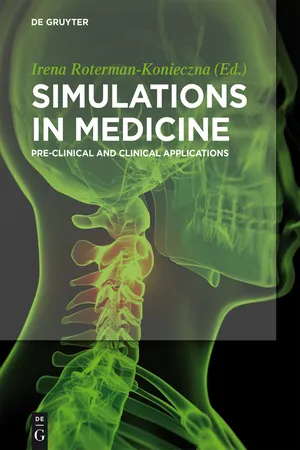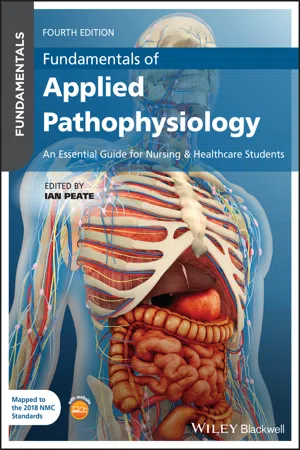Biological Sciences
Negative Feedback
Negative feedback is a regulatory mechanism in biological systems that helps maintain stability and homeostasis. It involves the response to a change in a system that counteracts the initial change, effectively dampening or reducing the magnitude of the change. This process helps to keep physiological variables within a normal range and prevent excessive fluctuations.
Written by Perlego with AI-assistance
Related key terms
9 Key excerpts on "Negative Feedback"
- eBook - ePub
- Irena Roterman-Konieczna, Irena Roterman-Konieczna(Authors)
- 2015(Publication Date)
- De Gruyter(Publisher)
Cellular levelPassage contains an image Jakub Wach, Marian Bubak, Piotr Nowakowski, Irena Roterman, Leszek Konieczny, and Katarzyna Chtopas
2 Negative Feedback inhibition – Fundamental biological regulation in cells and organisms
The functioning of biological systems is governed by the laws of physics and chemistry. Biological processes occur spontaneously and are subjected to thermodynamic regulation.Thermodynamics introduces a distinction between open and closed systems. Reversible processes occurring in closed systems tend to a state of equilibrium. This state is achieved when the reaction proceeds at an identical rate in both directions (from substrate to product and from product to substrate) – a situation which can be denoted v 1 = v 2 . In terms of energy transfer this state is inert, with nil spontaneity (ΔG = 0) (Fig. 2.1(a) ). In thermodynamically open systems (including all biological systems) equilibrium is not achieved spontaneously – it can, however, be maintained by continually replenishing the required substrates. This so-called stationary state is characterized by nonzero spontaneity ΔG ≠ 0) (Fig. 2.1 (b) ).Maintaining a stationary state requires regulation. In nonsentient systems, such as the interior of a cell, regulation must be automatic and is typically based on Negative Feedback loops, as shown in Fig. 2.2 .The Negative Feedback loop may be symbolically represented as a closed circuit in which a detector monitors the state of a controlled process while an effector counteracts detected changes. The function of the effector is dependent on signals received from the detector (see Fig. 2.2 ).In cells and organisms detectors are usually referred to as “receptors”. Most receptors are proteins which react with the products of a controlled process. Their genetically-conditioned affinity to a specific product enables them to control its concentration. Such structures can be found inside the cell, as well as in the cellular membrane, with receptors protruding into the environment and capable of registering external signals (Fig. 2.3 (a) , (b) and (c) - eBook - ePub
- Jeannette Naish, Denise Syndercombe Court, Jeannette Naish, Denise Syndercombe Court(Authors)
- 2018(Publication Date)
- Elsevier(Publisher)
- • Negative Feedback to depress the change if the variable level has increased beyond the narrow, set range. This is the commonest mechanism.
- • Positive feedback to affect an increase or acceleration in the output variable that has already been triggered. The result is to push the level beyond the physiological range.
- • Feedforward control to either depress or enhance the level of a variable before the change is needed, i.e. anticipatory (or open loop). Open-loop systems have no way to calibrate against the set point and so always need an accompanying closed-loop Negative Feedback to correct any over- or underanticipation.
Negative Feedback
Negative Feedback mechanisms can either increase or reduce the activity of tissues or organs back to normal, set levels, and the system is sometimes called a Negative Feedback loop ( Fig. 1.1 ) . Numerous examples of Negative Feedback exist in the metabolic processes of all physiological systems.Fig. 1.1 Negative Feedback loop. An increase in the variable produces an effector response to decrease it and a reduction in the variable leads to an effector response to increase it with the aim of returning to equilibrium.Homeostatic control of glucose metabolism
An example of a Negative Feedback system is the homeostatic control of blood glucose. Among the tissues of the body, red blood cells and the brain (under normal conditions) can only use glucose to generate the energy needed to drive metabolic processes. Glucose is essential to ensure an adequate supply of energy for the vital functions performed by these and other tissues. Blood glucose concentration (measured as fasting blood glucose) is therefore tightly maintained within a narrow range (3.5–8.0 mmol/L) normally. Here, the sensor is specialised pancreatic cells that receive blood from the portal circulation. The control is the autonomic nervous system, and the effectors are the α (secreting glucagon) and β (secreting insulin) pancreatic cells in the islets of Langerhans. A simplified explanation of glucose homeostasis is shown in Fig. 1.2 .Fig. 1.2 - eBook - ePub
Fundamentals of Applied Pathophysiology
An Essential Guide for Nursing and Healthcare Students
- Ian Peate, Ian Peate(Authors)
- 2021(Publication Date)
- Wiley-Blackwell(Publisher)
Nearly all physiological variables are controlled by Negative Feedback mechanisms. When a response reverses the original stimuli, then the system is operating by Negative Feedback.In Figure 3.3 , the regulation of blood pressure is considered. Watson (2018 ) provides an example of Negative Feedback and the maintenance of homeostasis in the regulation of blood pressure. When the heart beats faster or harder, the blood pressure increases. If a stimulus causes the blood pressure to rise, the baroreceptors (these are pressure‐sensitive nerve cells) located in walls of particular blood vessels send impulses to the brain (the control centre) having sensed higher pressure. The brain responds by sending out impulses to the heart and blood vessels (the effectors). Usually, as a result the heart rate responds and decreases, and blood vessels dilate, with the blood pressure responding by returning to normal. Blood pressure is discussed further in Chapter 9 of this text.There are many more examples of Negative Feedback mechanisms that occur in the body. Thermoregulation, control of blood glucose and osmoregulation are but three examples.Figure 3.2 Regulation through feedback, a feedback system(Source: Tortora and Derrickson (2017). Reproduced with permission of John Wiley and Sons, Inc.).Positive feedback mechanisms
The use of positive feedback mechanisms is less common in the control of physiological variables. When a response improves the original stimuli, then the system is operating by positive feedback. Figure 3.4 uses the positive feedback control of labour contractions during birth of a baby as an example of homeostatic regulation by a positive feedback mechanism.When labour commences, the cervix and uterus stretch (the stimulus), stretch‐sensitive nerve cells located in the cervix (the receptors) will transmit nerve impulses (the input) to the brain (this is the control centre). The brain responds, causing the pituitary gland to release the hormone oxytocin (the output), which then stimulates the walls of the uterus (the effector) to powerfully contract (the response) and to contract at a faster rate. When the fetus moves as a result of the contractions, this will also result in further stretching of the cervix and more oxytocin is released, resulting in even more forceful contractions. This cycle continues until the baby is born, the birth ends and the stretching of the cervix ceases, the release of oxytocin ends as well as the positive feedback mechanism. - eBook - ePub
- George Fink, Donald W. Pfaff, Jon Levine(Authors)
- 2011(Publication Date)
- Academic Press(Publisher)
In almost all physiological systems, the error signal is inverted in sign to produce an adjustment of the controlling element activity in the opposite direction of the original deviation from the set point. Virtually all neuroendocrine homeostatic mechanisms use some form of Negative Feedback control that can be described in these terms. Whether there are in fact distinct preselected “set points” that are regulated by simple servomechanisms such as the foregoing control system has been debated, and more complex – and likely distributed – control mechanisms have been proposed to regulate hypothalamic functions, such as thermoregulation. 15 Nevertheless, Negative Feedback mechanisms, and integrative mechanisms that defend a given range of values along a variable such as body weight, 16 or hormone secretion, are readily demonstrable for most neuroendocrine systems, and thus models such as these prove instructive in understanding the physiological relationships within these systems. FIGURE 1.5 Basic components of a simple controlled endocrine system featuring Negative Feedback regulation of secretion (see text for explanation of terms). Homeostatic Systems: Hypothalamic–Pituitary–End-Organ Axes Neuroendocrine homeostatic systems can involve the hypothalamus, anterior pituitary, and an end-organ or target tissues functioning together as an axis. These hypothalamic–pituitary–end-organ axes are organized into distinct tiers of regulated activity, arranged so that hormone signals are conveyed from: (a) hypothalamus to anterior pituitary by hypothalamic releasing and/or inhibiting factors secreted into the portal vessels; and (b) anterior pituitary to end-organ by adenohypophysial hormones secreted into the peripheral circulation. In many of these axes, a third round of signaling proceeds to complete a feedback loop from (c) end-organ back to hypothalamic neurons and/or anterior pituitary gland - eBook - ePub
Hormones as Tokens of Selection
Qualitative Dynamics of Homeostasis and Regulation in Organismal Biology
- Hugo van den Berg(Author)
- 2019(Publication Date)
- CRC Press(Publisher)
Chapter 2The nature of homeostasisHomeostasis refers to the tendency to maintain a constant or near-constant internal environment for the biochemical and physiological processes of life [102 ]. Familiar examples at the cellular level include the cytosolic concentrations of chemical species that affect the rates of metabolism (e.g. [H3 O+ ], [ATP], the intermediates of the Krebs† cycle) and at the organismal level physico-chemical parameters of interstitial fluids and blood, such as temperature, pressure, oxygenation, nutrient concentrations [78 ]. By maintaining such variables at constant or near-constant values, the body creates a stable and predictable milieu intérieur providing steady operating conditions for the processes of life, even when the organism’s ambient environment, the milieu extérieur , undergoes marked fluctuations or is severely perturbed.At the heart of homeostasis lies the principle of feedback control , also known as closed loop control. Life scientists perhaps shy away from the term ‘control’ to avoid unintended teleological imputations and may prefer to speak of regulation ; however, the hallmark of regulation is the use of feedback to attain what engineers unabashedly call ‘desired behaviour’ [64 ]. In a biological context, ‘desirable’ has to be understood as a shorthand for ‘conferring adaptive value,’ as we will argue in Section 2.1 . Moreover, the biological context requires a slightly different mathematical formalism than the classic engineering context, because coarse-graining and time-scale arguments are essential for tractable models of complex biological systems [11 ]. The basic notions and notations used in the chapters that follow are introduced in Section 2.2 .2.1The Origins of HomeostasisInformation science in its broadest meaning presents itself as the medium of choice for the study of biological regulation. Control and homeostasis find a natural fit in what used to be called cybernetics , the theory and craft of process control (from κυβερνητική, the art of the maritime pilot). However, there are differences in outlook and parlance which engender unnecessary confusion and debate. For instance, control engineers call the value that is maintained the ‘reference value,’ or ‘desired value,’ or ‘set-point’ [39 ], terms which may worry the biologist, since the system operates without conscious desires or goal-orientation [38 ].‡ - eBook - ePub
- Kenneth Sayre(Author)
- 2014(Publication Date)
- Routledge(Publisher)
Let us summarize our discussion of Negative Feedback as a form of information processing. According to the Second Law of Thermodynamics, the entropy of a closed system tends generally to increase, and the system accordingly tends to diminish in structure. This process is manifest in the tendency of systems to lose their operating effectiveness unless their structure is constantly replenished. One means of structural replenishment is by the ministration of corrective procedures initiated outside the system itself, illustrated (in society) by the repair of machines and (in nature) by symbiosis between members of different species. The method of structural replenishment most often employed in biological systems, however, is that of Negative Feedback, in which destructuralizing influences are counteracted by procedures initiated by the system itself. These countermeasures require the operation of effectors capable of exerting energy to correct system deviation from normal operating conditions, and the operation of sensors providing information for the control of the effector mechanisms.Negative Feedback thus may be conceivied as a process through which structure lost (entropy gained) as a result of normal operation is compensated by negentropy derived from the operating environment. This negentropy comes both in the form of energy channeled through the system’s effectors, and in the form of information by which these effectors are guided in response to environmental contingencies.Negative Feedback is a mode of interaction by which a system gains structure at the expense of energy extracted from its operating environment. This interchange of energy is a causal transaction. How are we to conceive the causal relationships involved?Notes
- This process is described in nontechnical detail by Wooldridge (1963
- eBook - ePub
The Physiological Basis of Behaviour
Neural and Hormonal Processes
- Kevin Silber(Author)
- 2005(Publication Date)
- Routledge(Publisher)
6 HomeostasisIntroduction
In this chapter we consider homeostasis as an example of how the CNS, ANS and endocrine system work together. The term homeostasis refers to the maintenance of a relatively stable state within our bodies. In the first part of the chapter we take a closer look at exactly what this means. The rest of the chapter details three major homeostatic mechanisms, namely, the regulation of our nutritional content (eating), the regulation of our water content (drinking), and the regulation of our body heat (temperature regulation). As you work through the chapter you will see that all three mechanisms are kept in balance by a combination of hormonal and ANS activity, all of which is coordinated by central brain processes.What is homeostasis?
There are a number of features of homeostasis that are worth pointing out before we look at the details.As I am writing this book in World Cup year I will start, if I may, with a football analogy. Imagine that you want to have a game of football. If the ball is not pumped up enough then it will not bounce properly. If it is blown up too much then it will burst. Indeed, professional footballers will tell you that small diversions from the correct pressure make it difficult to play properly. There is, therefore, a limited range of pressures over which the football can function as a football. The same is true of the constituents of our bodies. For example, many of the chemical reactions in our body are helped by the presence of enzymes. Enzymes will only work within a limited temperature range. Therefore, the body must maintain its temperature within certain limits. The mechanisms for this and all of the other balances are called homeostatic mechanisms.- The ideal range for any component is called the set point
- eBook - ePub
Applied Systems Analysis
Science and Art of Solving Real-Life Problems
- F. P. Tarasenko(Author)
- 2020(Publication Date)
- CRC Press(Publisher)
regulator . Leverage force can be both the creation of a missing feedback loop, and the modification of some operations in the existing regulator.Negative Feedback is a powerful keypoint and is present in many artificial and natural systems. Examples include various automatic control systems (thermostat, refrigerator, current or voltage stabilizers, autopilot, Watt’s regulator, etc.); sometimes the role of the regulator is played by a person (driver, pilot, machine operator), or an entire organization (legislative body, executive authorities), or a specially created system of relations in society (market economy, election of authorities); feedbacks play a huge role in the existence of living organisms, ensuring their viability in changing external conditions (adaptation systems, immune system, conditioned reflexes).When choosing Negative Feedback as a keypoint for desired changes in a complex system, it is necessary to keep in mind a number of related features and difficulties in realizing this possibility.First, regulation can compensate deviations from the target trajectory only within certain limits. Deviations can be so strong and fast that regulation simply cannot cope with them. Open the windows in the room and the air conditioner will not be able to maintain the preset room temperature. Hit the car on the ice and nothing will keep it on the road. Revolt the crowd and the police will not be able to restore order. The rate of logging, which exceeds the rate of forest recovery, leads to the loss of forests.Second, we should not forget about the counterintuitiveness of complex systems. Often, even correctly found leverage point they begin to stimulate in the wrong direction. As an example, Donella Meadows [5] often cites erroneous government measures to regulate finances (prices, taxes, subsidies) in a market economy. - eBook - ePub
- Robert G. Carroll(Author)
- 2006(Publication Date)
- Mosby(Publisher)
Fig. 1-3 ).Figure 1-3 Negative Feedback control matches body temperature to the thermoregulatory set point. The anterior hypothalamus compares the body core temperature against the set point. If the two do not match, an error signal is generated, which results in a compensatory change in the heat gain/heat loss balance of the body. This change should bring body core temperature back to the set point.The acute regulation of arterial blood pressure by the arterial baroreceptors (the baroreceptor reflex) is a prototype for physiologic Negative Feedback control systems. Normal blood pressure is taken as the set point of the system. The sensing mechanism is a group of stretch-sensitive nerve endings in the walls of the arch of the aorta and in the walls of the carotid arteries near the carotid bifurcation. These nerve endings are always being stretched, so there is always some background firing activity. The rate of firing of these receptors is proportionate to the stretch on the blood vessels. Stretch (and therefore firing) increase as blood pressure increases, and a decrease in stretch (and therefore a decrease in firing rate) accompanies a fall in blood pressure. The afferent nerves from these receptors synapse in the cardiovascular center of the medulla, where the inputs are integrated. The efferent side of the reflex is the parasympathetic and sympathetic nervous systems (PNS and SNS), which control heart rate, myocardial contractility, and vascular smooth muscle contraction.A sudden drop in blood pressure leads to a decrease in stretch on the baroreceptor nerve endings, and the decrease in nerve traffic leads to a medullary mediated increase in sympathetic activity and decrease in parasympathetic nerve activity. Increased sympathetic activity causes vascular smooth muscle contraction, which helps increase peripheral resistance and restore blood pressure. Increased sympathetic nerve activity also increases myocardial contractility and, together with the decrease in parasympathetic activity, increases heart rate. The resultant increase in cardiac output also helps restore blood pressure. As blood pressure recovers, the stretch on baroreceptor nerve fibers returns toward normal and the sympathetic activation diminishes. Table 1-3
Index pages curate the most relevant extracts from our library of academic textbooks. They’ve been created using an in-house natural language model (NLM), each adding context and meaning to key research topics.








